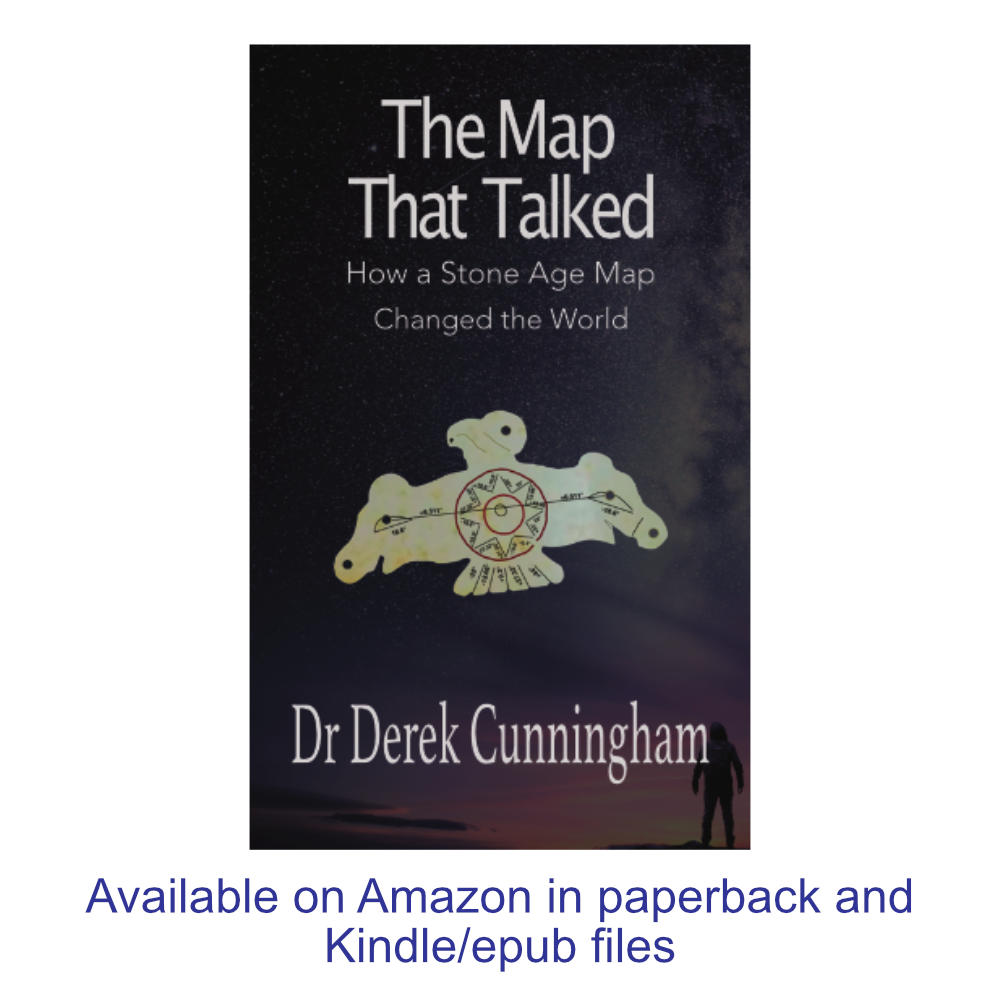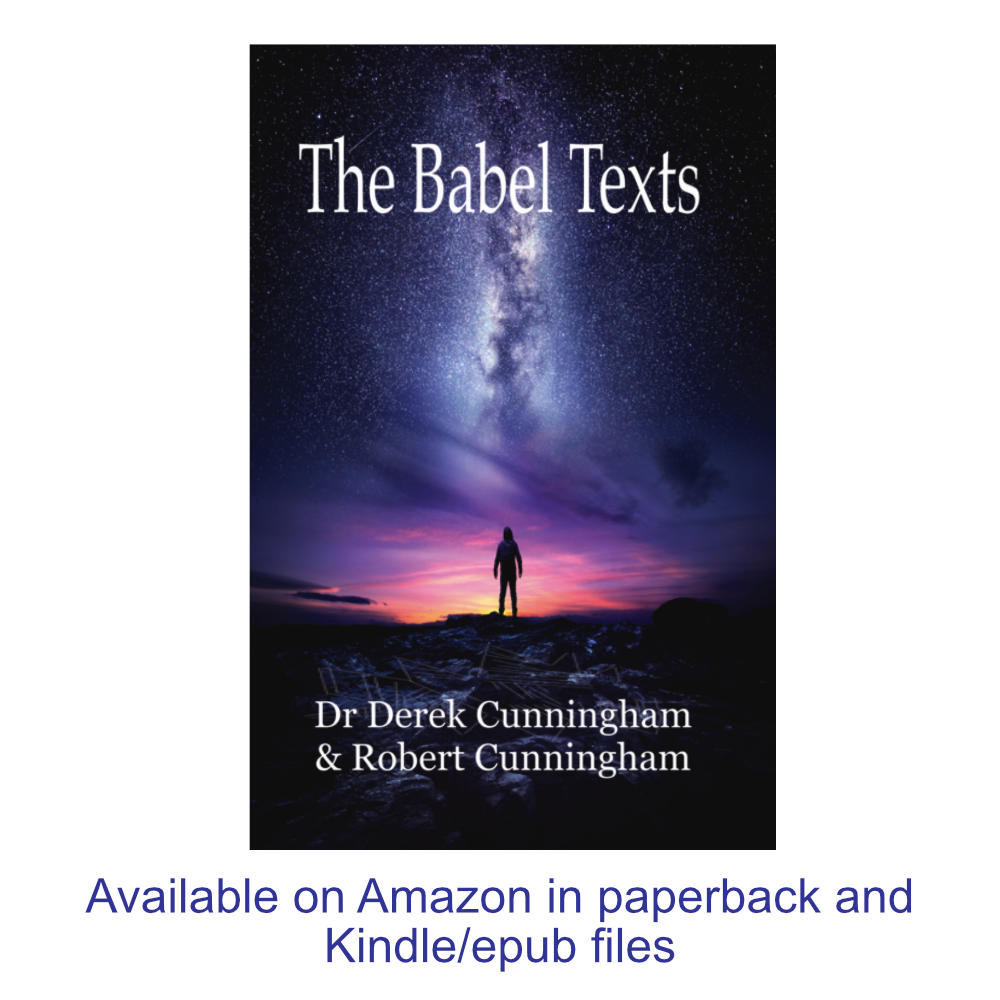Abstract – Unlike prior statistical studies, which confirm the lines in ancient geometric patterns are based on astronomical values, the proposed secondary meaning behind these geometric lines (this being the four-fold symmetry that is seen in early geometric patterns is linked to an archaic alphabet) will continue to require further study. At the current time, only one prior study has attempted to extract the phonetic code behind these lines. This study involved analysing the structure of the carving of the animals, the diameter of the circles present, and the location of the eyes of the animals on the Lingjiatan Jade Eagle pendant, and identifying that the angles used in creating the eight-pointed star were symmetric, and when all elements were combined the entire pendant appears consistent with describing the orbits of the planets. This result would appear unlikely, but it is consistent with another study by the author, which shows that Stonehenge, which dates to approximately the same time period, can also map the orbits of the planets, through using the locations of the now missing wooden posts. In this study the aim is to analyse the reverse side of the Lingjiatan Jade Eagle. From this study it is found that the angles presented by the lines on the reverse side are very closely connected to the lines present on the front side. However, even though 10 out of the 16 lines (which is equivalent to 62.5% of the pattern) are identical and match the lines present on the front side of the pendant, there are differences in the remaining six lines. These six lines are evenly spread amongst six line-pairs, which argues it is possible that the meaning behind these lines on the reverse side is connected to the front side, and the difference might be linked to a specific astronomical feature that is visible to an observer on Earth. However, further finds from the Lingjiatan area will be required to confirm whether this is correct, and at this moment the full meaning behind the lines on the reverse side cannot be confirmed with 100% certainty.
Author: Derek Cunningham
Introduction
in earlier studies1-6, it was noted that the astronomical values used to create the Babel Text6 are able to explain many ancient mysteries. For example, the astronomical values present in this ancient text can explain the latitude and longitude of many the world’s oldest sites all around the world1; they also explain the structure of the mysterious Mayan Calendar1 and perhaps of greatest significance is the ability of the lines to explain both the need and the dates given for the periodic reset of the Mayan Calendar, which last occurred on the 21st December in the year 20121. The same astronomical values and their various links to the night sky can also be used to explain the Greek myths that surround the constellations, such as the story that Cancer the Crab bit Hercules’ toe and was thus kicked far away to it’s current location in the night sky1,2. The lines also explain the Norse story surrounding Ragnarok1; and the same astronomical values can also explain the layout of the Great Pyramids1,2.
However, despite confirming the lines are not random, and despite showing that a very small group of astronomical values can explain so many different, and unrelated ancient mysteries, the theory remains ignored.
The Lingjiatan Jade starburst diagram is of substantial interest, because similar images have been found worldwide. Amongst these the closest comparable is perhaps starburst image found on the Babylonian World Map.
In the author’s earlier studies on the structure of these lines, and the map these simple astronomical lines create, it was argued that the Babylonian World Map is based upon a decision that was made by a much earlier civilisation to divide the night sky into three blocks or parts1. This was done so that no matter where the Earth is in its yearly journey around the sun, all the stars visible in a 120-degree field of view will remains relevant to a person standing on Earth for navigation; and thus each “layer”, each 120-degree section of the night sky, can be brought down to the surface of Earth, to then map specific locations on Earth using the stars and the constellations1. This is the reason for the unusual stories, which surround the constellation1, and the reason for Cancer the Crab being flung across the night sky after biting the toe of Hercules1.
The problem is, even though it is now proven, using statistics3, that the Babel Text was used worldwide1-3, and it was used unchanged for hundreds of thousands of years1-3, it is not easy to construct a statistical study, or a percentage probability to explain the conceptual differences in the structure of the lines that can be seen on the two sides of the Lingjiatan Jade Eagle4. In this study the lines are analysed to determine the statistical probability for the overlap seen, and a preliminary explanation is presented to explain the differences seen.
Statistical Analysis
In the images provided below, the structural similarities between the Lingjiatan Jade Eagle and the Babylonian World map can be seen.
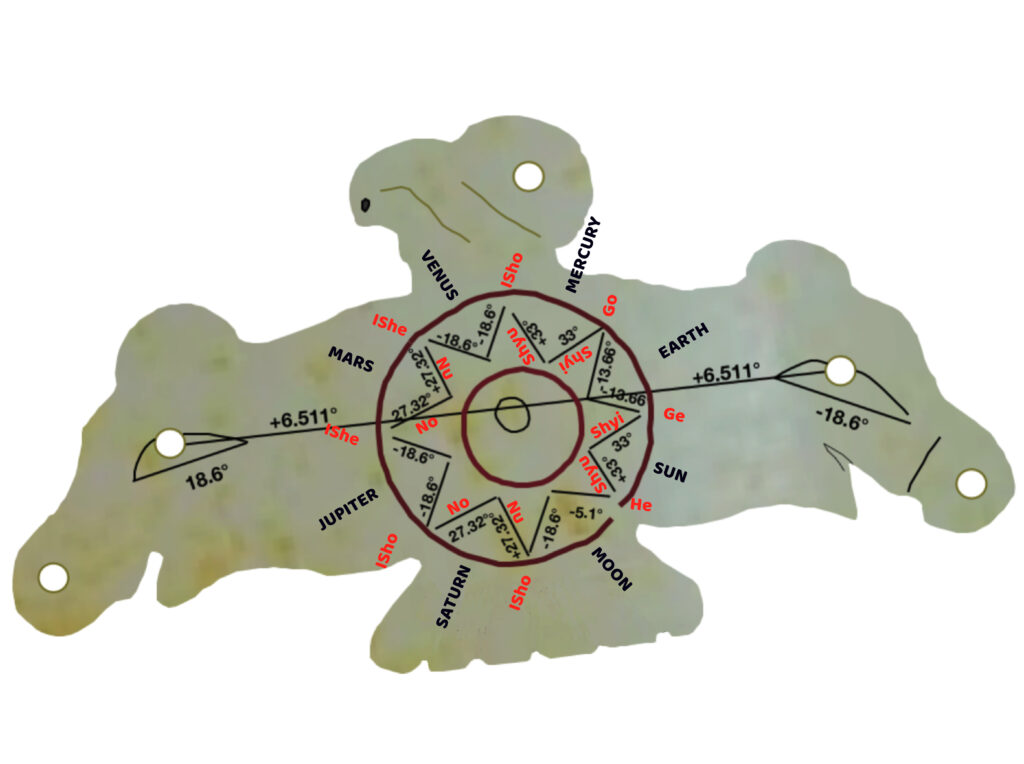
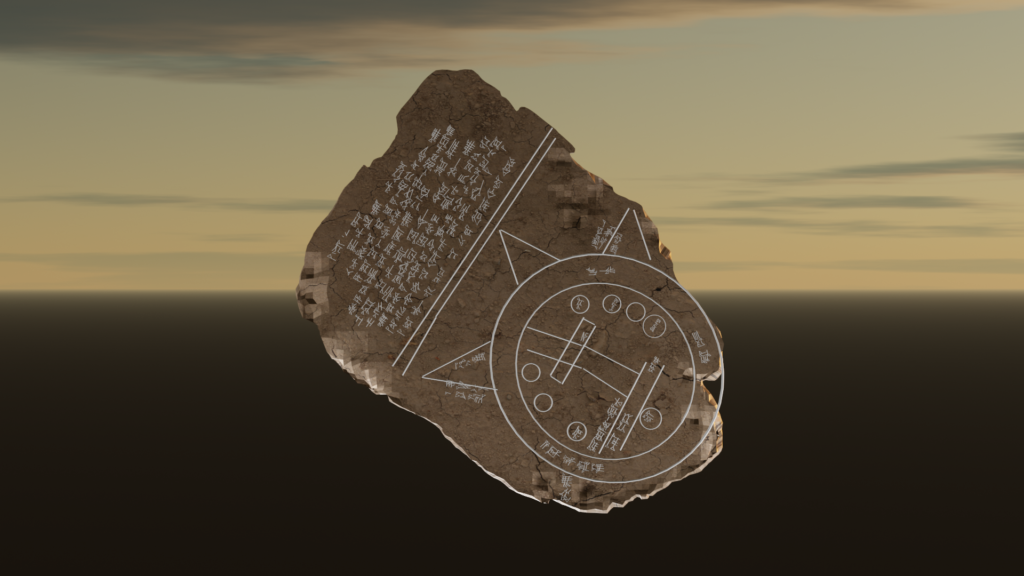
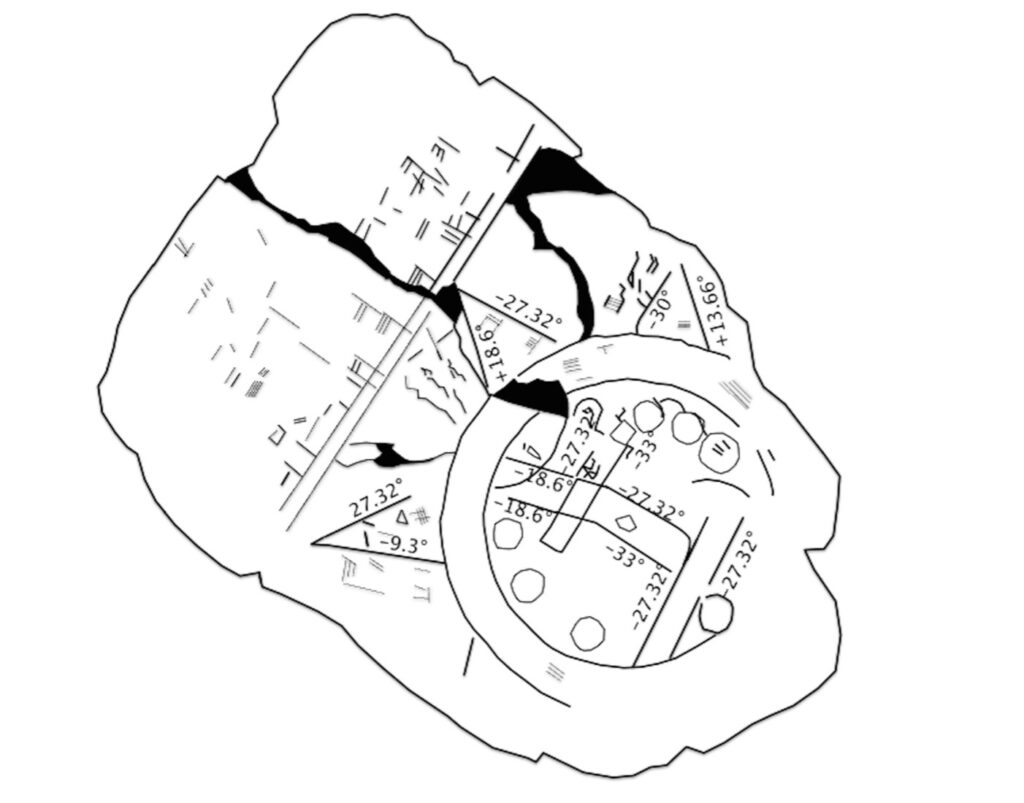
With the angles of the lines now known to be not random and are linked to the astronomical values that are critical for measuring time, this makes it reasonable to argue that the pendant might be a description of the night sky; and in the author’s prior studies1-5 it was noted that the pendant can describe the orbits of the planets, as shown in the video below.
It thus appears reasonable to assume these 8 triangles on the front side of the Lingjiatan Pendant do represent the names of the five visible planets, and the Earth, moon and sun. However, until now, no studies have been undertaken on the lines present on the reverse side of the pendant.
In Fig. 3, the angles present on the two sides of the pendant can be compared.
It should be noted that by rotating the object 180 degrees, if the lines were random, the angles present on the reverse side should not match the proposed Babel Texts, nor should they be consistent with the lines present on the front side of the pendant.
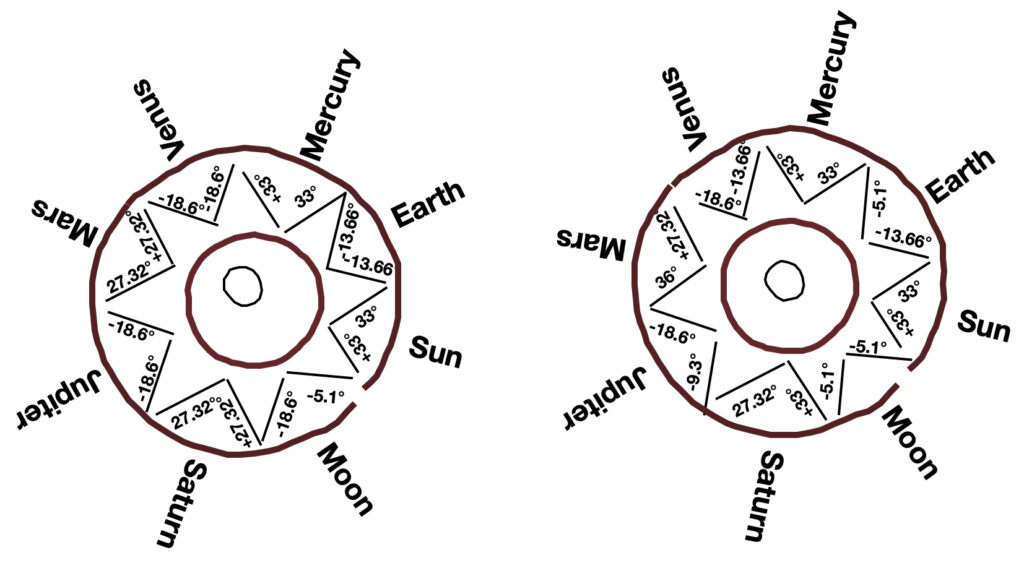
If it is assumed that the error in reading the angles present on the Jade Eagle is in the order of ±1.0 degree, this would permit a 45 degree block of space to be divided into 22.5 regions. For statistics half values are not desirable. Thus the analysis will assume the error bar is slightly larger and each region of 45 degrees can be divided into 22 blocks. This is based on each line exhibiting four-fold symmetry, which permits the same lines to appear above and below the horizontal and to the left and right of vertical.
In prior studies it is assume that the name for each celestial object, and one pair, which might be the name of Earth, is given by a pair of lines that connect to form a triangle pointing inwards, twoards the center of the star. This was assumed, because there is a symmetry in the angles of the lines, when this approach is used, and this permits a symmetry in the phonetic code, which does appear to match the earliest known names that were given to the moon and the planets. It should be noted that even though one pair was ascribed to the planet Earth, this specific line-pairmight be describing another celestial object, such as the Milky Way, or perhaps the Heavens in general.
By rotating the Jade Eagle 180 degrees to view the reverse side it is found that there are two identical line pairs. the statistical probability for four lines to appear in the same order and to be connected is related to the number of possible angles that can be read with an average accuracy of circa ±1.0 degree in the reading of the angles. In combination theory there are 22C1 chance for a line to align to any one specific 45-degree block. However, in this case the specific orientation of the line is fixed. Thus the chance for just one line to align to the same angle is 88C1, which is equal to 1 in 88 chance.
However, this argument is only for one line. In this case, within the two line-pairs that argued from prior studies to represent the Sun and planet Mercury, which is an intriguing coincidence in itself, there are four independent lines, which in statistical studies need to be analysed as if they are independent probabilities. This is calculated to be equal to a 1 in 59,969,536 chance for these four specific lines overlapping.
In terms of statistical significance, this is below the .01 value that is usually used to mark a result as being statistically significant.
In total there are 10 lines that match, when the pendant is rotated by 180 degreees. In statistics the probability for this occurring by chance is only 1 time in 2.875 x 1019 attempts. This argues the chance for these lines being random is vanishingly small, and thse lines were intentionally aligned to these specific astronomical angles.
Note: from the prior statistical study3 the chance for the lines to be random and it is only through luck that they align to these specific astronomical values, and the angles also show four-fold symmetry and in this study it is now shown that there is a mirror image with the two patterns being identical on the two sides of the Jade Eagle, is in the order of 1 event in 8.5 x 1091, which is well beyond the six sigma certainty that is required to argue a result is proven in High Energy Physics Experiments.
The only problem is the structure of the Babel Text on the reverse side of the Jade Eagle does show some subtle differences.
If we assume the translation offered for the front side of the Jade Eagle (in which the eagle head is looking to the left) is correct1,4, and the front side does provide us with the names of the visible celestial objects (with one pair perhaps the word for Earth or another celestial object) then the same order for the planets can then perhaps be used on the reverse side of the Jade Eagle. As mentioned earlier, this is a preliminary study, and further research is required.
In this case the line-pair for Mercury and the Sun remain the same, but the pair that was originally assigned to Earth switches from [-13.66(b), -13.66(r)] to [-13.66(b), -5.1(r)]. In addition, the line-pairs for the planets (Venus, Mars Jupiter and Saturn) also show a change which each line-pair showing a change in the angle of just one of the lines.
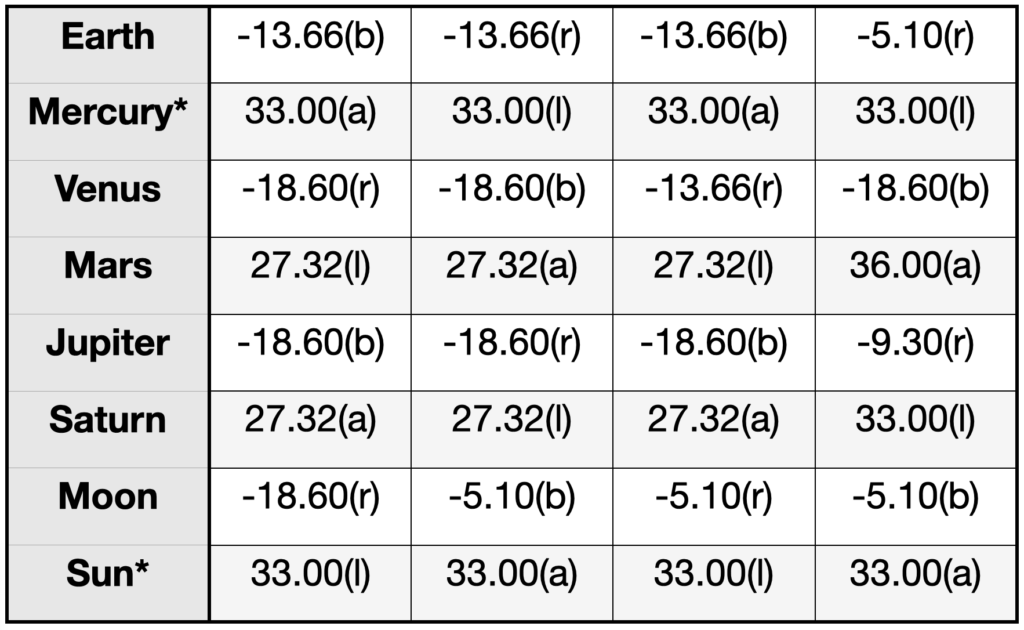
These half-changes in the observed angle appear to suggest the two sides are indeed related, but the lack of any consistency in the replacement angles makes it very difficult to know what the link might be.
One possible explanation (which obviously cannot be tested until more examples of this text can be recovered) is the second side might be linked to the waxing and waning of the planets and the moon.
In the case of planets, the Sun and Mars will form their ‘waxing angle’ between conjunction and opposition, while the waning angle between the Sun and Mars will appear from their opposition to the their next conjunction. In the case of the moon, one simple way to tell if the moon is in its waxing or waning phase is see which side of the moon the shadow is on. If the shadow is on the right side, then the moon is in its waning phase.
The advantage that this explanation has it is still linked to the planets, and only “half” of the story is changing. In the case of the moon, this is easily seen by the change in shape from a crescent moon to a full moon.
One other possibility is the difference in the structure of the line-pair might be linked to the duration that the planets spend above and below the ecliptic plane.
The problem is there is just not enough information from just one example from the Lingjiatan region, to know for certain which explanation is most relevant.
What is certain is the 8-pointed star was used worldwide, and it is only in more modern texts that it is assumed that the 8-points must represent only the sun. Intriguingly, in Plato’s books on cosmology he described a two-sphere model and said there were eight circles or spheres carrying the seven planets and the fixed stars. Here there are two circles and eight structures that can be described as triangles.
Here it might be worth noting that in China there are the 8 triagrams, which are collectively called Bagua (八卦). However, These triagrams are not based on any truly ancient knowledge. In the 3,000 year old i-ching, the 8 trigrams are based upon an earlier angular and astronomical version, and converted to the series of parallel solid and broken lines that we know now, with the four-fold symmetry reduced to just a mirror plain. The eight hexagrams linked to the elements and the entire heavens are compressed into just one of the triagrams. The 8 triagrams are as follows
- ☰ Ch’ien or Qian (The Creative), Strength, Image – Heaven 乾
- ☷ K’un (The Receptive) Devoted, Image – Earth 坤
- ☳ Chen or Zhen (Motion, transition), Image – Thunder 震
- ☵ K’an or Kan (Danger), Image – Water 坎
- ☶ Ken or Geb (Rest or immobility), Image – Mountain 艮
- ☴ Sun or Xun (Penetration), Image – Wind/Air 巽
- ☲ Li (Light Giving), Image – Fire 離
- ☱ Tui or Dui (Joy), Image – Lake 兌

The legends surrounding the 8 trigram symbols are they were created first over 3,000 years ago by a legendary figure called Fu Hsi, and they were a modification of earlier systems that were then in place. This older system was ascribed to an ancient map that was created by “The River” (The Milky Way) and the map was borne by a horse. In modern texts this is simplified to a rigid square box in which there is a grid of dots.

The dot-map of the world appears strange. It is created using a series of dots that are grouped together with each group exhibiting a different number. The mentioned River that is linked to this map is sometimes considered to be The Milky Way (in 19th century books the authors argued it was linked to the Yellow River). When taken together, this could argue that the dots are stars, or constellations, with perhaps the number of the dots in each group representing the number of stars in a constellation.
Though Confucious stated, circa BC 1079, that this “map”, and other curiosities were then still preserved in the royal court, with the passage of time these ancient documents no longer survive. The discussion of the great dragon that is linked to this dot map and how it is able to map the world using the Milky Way and the constellations is described in more detail in my earlier studies1.
Discussion and Conclusions
At this point, more studies are required. Within Chinese text books there are other examples of this type of Jade Eagle with sunburst symbol. These images are often described as being early examples of the Phoenix, but there are few published images of these geometric patterns, and these images tend to be taken at oblique angles, which prevent the angles present within these patterns from being analysed.
However, despite this problem, the replication of the angles on both sides of this Jade Eagle does confirms the lines are aligned to astronomical values. This argues this pendant contains some of the earliest surviving Chinese texts.
References
- The Map That Talked, CreateSpace Independent Publishing Platform, first published Nov 2012, current edition published 2018.
- The Babel Texts, CreateSpace Independent Publishing, 2018
- Derek Cunningham, New Study Reveals Stone Age People Could Read – and were Homo sapiens the first species to learn to write?, Babel Texts Research Letters, February 25, 2024.
- The Oldest Names of the Planets: The Lingjiatan Jade Eagle, Babel Text Research Letters, March 9, 2024.
- Derek Cunningham, Use Of The Babel Text At The SanXingDui Site In China, Babel Text Research Letters Feb 25 2024.
- Derek Cunningham, Stonehenge And The Orbits Of The Planets. Do The Ancient Wood Posts Surrounding Stonehenge Mark The Planets Orbits? Babel Text Research Letters Feb 25 2024.
- the image on the second side is found in the publication by J.G. Cheock, see Austronesian Myth or History https://www.google.com/books/edition/Austronesian_Myth_or_History/JlukEAAAQBAJ?hl=en&gbpv=1&dq=jade+eagle+Lingjiatan&pg=PA18&printsec=frontcover).
- The Sacred Books of the East: The I Ching edited by Friedrich Max Müller, page 6, King Wan dated to 1143


